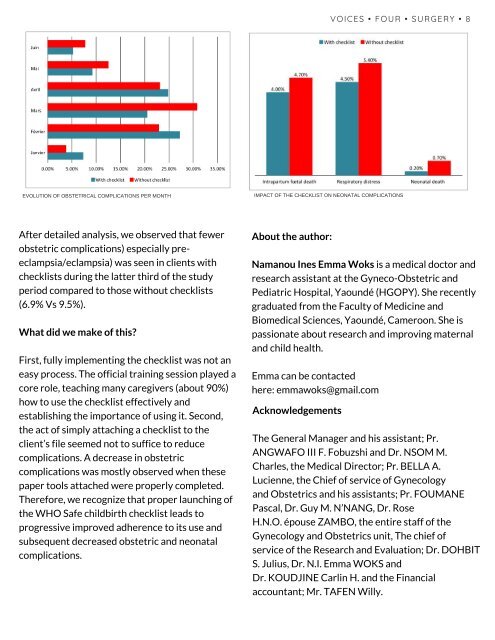Safety First - Voices of One Surgery - Issue 4: December 2018
As we celebrate 10 years of the launch of the World Health Organisation Surgical Safety Checklist and the success it gave, One.Surgery recognises the many challenges that still exist today in the pursuit of providing safe surgery to every patient worldwide.
As we celebrate 10 years of the launch of the World Health Organisation Surgical Safety Checklist and the success it gave, One.Surgery recognises the many challenges that still exist today in the pursuit of providing safe surgery to every patient worldwide.
You also want an ePaper? Increase the reach of your titles
YUMPU automatically turns print PDFs into web optimized ePapers that Google loves.
VOICES • FOUR • SURGERY • 8<br />
EVOLUTION OF OBSTETRICAL COMPLICATIONS PER MONTH<br />
IMPACT OF THE CHECKLIST ON NEONATAL COMPLICATIONS<br />
After detailed analysis, we observed that fewer<br />
obstetric complications) especially preeclampsia/eclampsia)<br />
was seen in clients with<br />
checklists during the latter third <strong>of</strong> the study<br />
period compared to those without checklists<br />
(6.9% Vs 9.5%).<br />
What did we make <strong>of</strong> this?<br />
<strong>First</strong>, fully implementing the checklist was not an<br />
easy process. The <strong>of</strong>ficial training session played a<br />
core role, teaching many caregivers (about 90%)<br />
how to use the checklist effectively and<br />
establishing the importance <strong>of</strong> using it. Second,<br />
the act <strong>of</strong> simply attaching a checklist to the<br />
client’s file seemed not to suffice to reduce<br />
complications. A decrease in obstetric<br />
complications was mostly observed when these<br />
paper tools attached were properly completed.<br />
Therefore, we recognize that proper launching <strong>of</strong><br />
the WHO Safe childbirth checklist leads to<br />
progressive improved adherence to its use and<br />
subsequent decreased obstetric and neonatal<br />
complications.<br />
About the author:<br />
Namanou Ines Emma Woks is a medical doctor and<br />
research assistant at the Gyneco-Obstetric and<br />
Pediatric Hospital, Yaoundé (HGOPY). She recently<br />
graduated from the Faculty <strong>of</strong> Medicine and<br />
Biomedical Sciences, Yaoundé, Cameroon. She is<br />
passionate about research and improving maternal<br />
and child health.<br />
Emma can be contacted<br />
here: emmawoks@gmail.com<br />
Acknowledgements<br />
The General Manager and his assistant; Pr.<br />
ANGWAFO III F. Fobuzshi and Dr. NSOM M.<br />
Charles, the Medical Director; Pr. BELLA A.<br />
Lucienne, the Chief <strong>of</strong> service <strong>of</strong> Gynecology<br />
and Obstetrics and his assistants; Pr. FOUMANE<br />
Pascal, Dr. Guy M. N’NANG, Dr. Rose<br />
H.N.O. épouse ZAMBO, the entire staff <strong>of</strong> the<br />
Gynecology and Obstetrics unit, The chief <strong>of</strong><br />
service <strong>of</strong> the Research and Evaluation; Dr. DOHBIT<br />
S. Julius, Dr. N.I. Emma WOKS and<br />
Dr. KOUDJINE Carlin H. and the Financial<br />
accountant; Mr. TAFEN Willy.








